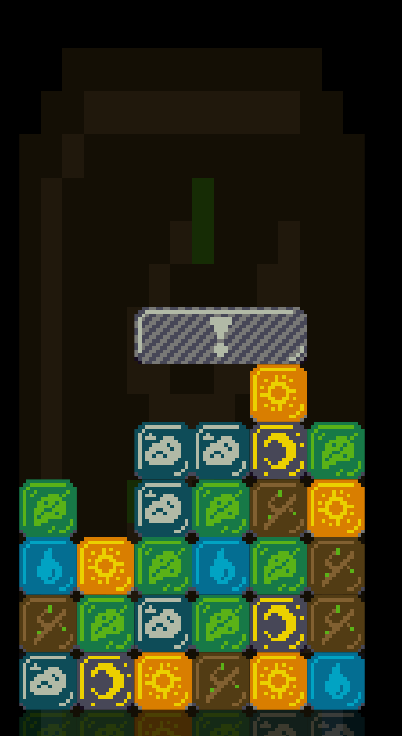Added falling and grid representation to garbage blocks
2019-03-27
Project Page
Today I added the garbage blocks to the grid and implemented physics for them. Unfortunately much of this code is fairly close to the block physics, but modified to support blocks larger than a single block wide. For now I am ok with the repeated code since its only in two places and there is a fundamental difference, but in the future I may try to pull out the shared bits.
Garbage Class
The first step was to create a class for the garbage blocks in order to manage state and property access.
export class Garbage {
constructor(left, gridDimensions) {
this.gridSlot = new Vector(left, previousFilledY - gridBlockDimensions.height - gridDimensions.height);
this.gridPosition = this.gridSlot.clone();
this.gridDimensions = gridDimensions;
this.type = type.GARBAGE;
this.state = state.FALLING;
}
render() {
let blocksTopLeft = new Vector(
gridCenter.x - gridDimensions.width / 2,
gridCenter.y - gridDimensions.height / 2 + blockPixelAdvancement);
let renderInfos = garbageRenderInfo(this.gridDimensions);
let topLeft = blocksTopLeft.add(this.gridPosition.multiply(blockWidth).multiplyParts(new Vector(1, -1))).withZ(2);
for (let renderInfo of renderInfos) {
image(renderInfo.texture, topLeft, renderInfo.dimensions, 0, Color.White, Vector.topLeft);
topLeft = topLeft.add(new Vector(0, -renderInfo.dimensions.height));
}
}
}
Grid Management
At this point the garbage block is very similar to the normal blocks. I moved
the grid rendering code into the class render method. Then getting the block
to render is as simple as setting the block into the correct grid position.
Unfortunately since the garbage blocks take up more than a single slot, I needed
to modify the grid access functions accordingly.
let blocks = {};
export function getBlock(gridSlot) {
let row = blocks[gridSlot.y];
if (row) {
return row[gridSlot.x];
}
return undefined;
}
export function setBlock(block) {
let topLeft = block.gridSlot;
for (let overlappingSlot of block.overlappingSlots()) {
if (!blocks[overlappingSlot.y]) {
blocks[overlappingSlot.y] = [];
}
blocks[overlappingSlot.y][overlappingSlot.x] = block;
}
}
export function clearSlot(position) {
if (blocks[position.y]) {
delete blocks[position.y][position.x];
}
}
export function* allBlocks() {
let seenBlocks = new Set();
let rowYValues = Object.keys(blocks);
let topRow = Math.min(...rowYValues);
let bottomRow = Math.max(...rowYValues);
for (let y = bottomRow + 1; y >= topRow; y--) {
let row = blocks[y];
if (row) {
for (let block of row) {
if (block && !seenBlocks.has(block)) {
yield block;
seenBlocks.add(block);
}
}
}
}
}
getBlock stayed the same, but setBlock now sets the block into every slot
which the block overlaps. Similarly instead of just yielding blocks directly in
allBlocks, a set of already yielded blocks is maintained so that blocks aren't
rendered more than once. Lastly I split clearSlot out of setBlock so that I
no longer do duck typing to decide whether to clear or set a block into a
position.
overlappingBlocks
Importantly I added a function to both garbage and standard blocks which returns
the list of grid positions which are overlapped by said block. For standard
blocks its as simple as returning the gridSlot in an array:
overlappingSlots() {
return [ this.gridSlot ];
}
For garbage blocks overlappingBlocks is a generator which returns the slots
covered by the rectangle of the garbage block.
* overlappingSlots() {
for (let x = this.gridSlot.x; x < this.gridSlot.x + this.gridDimensions.width; x++) {
for (let y = this.gridSlot.y; y < this.gridSlot.y + this.gridDimensions.height; y++) {
yield new Vector(x, y);
}
}
}
Note: the * is important to indicate that the class method is a generator
function.
Falling
Falling for garbage blocks is also pretty similar to the standard blocks except any filled slot below the garbage block is sufficient to stop the entire block from moving. To that end I wrote a simple function which decides if there is a gap under the garbage block to move to.
gapBelow() {
let gapBelow = true;
for (let x = this.gridSlot.x; x < this.gridSlot.x + this.gridDimensions.x; x++) {
if (getBlock(new Vector(x, this.gridSlot.y + this.gridDimensions.height))) {
gapBelow = false;
break;
}
}
return gapBelow;
}
I then use this in the handleFalling method which gets called by update.
handleFalling() {
if (this.state === state.CLEARING) return;
if (this.gapBelow()) {
this.state = state.FALLING;
}
if (this.state === state.FALLING) {
this.gridPosition.y += fallSpeed;
if (this.gridPosition.y > this.gridSlot.y && !this.gapBelow()) {
this.gridPosition.y = this.gridSlot.y;
this.state = state.WAITING;
} else {
let previousSlot = this.gridSlot.clone();
let newY = Math.ceil(this.gridPosition.y);
if (newY != this.gridSlot.y) {
for (let slot of this.overlappingSlots()) {
clearSlot(slot);
}
this.gridSlot.y = newY;
setBlock(this);
}
}
}
}
update() {
this.handleFalling();
}
The main difference here from standard is that I clear each overlapping slot instead of the single previous gridPosition when the block is falling.

And thats about it. Beyond these changes I added some checks in the standard block code to make sure you cannot swap with a garbage block, made it so that Bang blocks no longer spawn in the random blocks (I will add these back once I build metal garbage blocks), and I change the background to be a random standard block.
Next up is to implement a clear animation and have garbage blocks watch matches to decide when to clear themselves. Then I will need to make sure that combos can be extended through garbage block clears.
Till tomorrow,
Kaylee